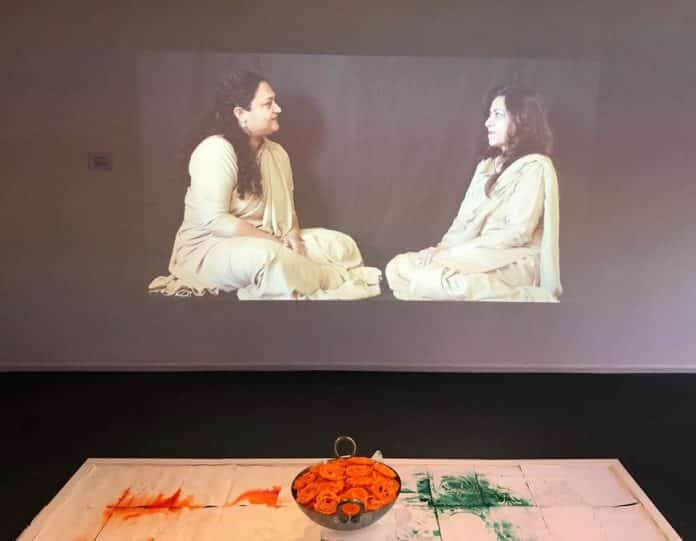On 17 August, 1947, the border between the newly independent states of India and Pakistan was officially created. Drawn up by British lawyer Cyril Radcliffe (hence the name The Radcliffe Line), it was the product of inexperience (Radcliffe had never been to India before), ignorance (he was consulting out of date maps), and indifference to the possible human cost of such a hurried, ill-considered slicing up of an ancient, vast and complex polity.
This turned out, as we know, to be cataclysmic: the largest migration in human history and at least one million lives lost in the bloody conflict that accompanied it.

That a physical, legal and political border exists between the nation-states of India and Pakistan today is fact. But does it have any other existence? Where does it reappear, and where does it dissolve?
One space that it arguably disintegrates is in the South Asian diaspora. It this ‘third space’ relationship that is explored by contemporary artists Anindita Banerjee and Wardah Alam in their joint exhibition, Sarhad, currently on display at KINGS Artist-Run in Melbourne. In it, Ray and Alam, both immigrant artists, explore the “fragile, transitory and melting” nature of the Indo-Pakistani border in the Australian South Asian diaspora.
The artists have spent 15 months working together, exploring the role contemporary art can play in, as Banerjee phrased it, “dissolving borders and creating connections”. “We went through a whole process, starting with the question of whether it [the border] exists,” she said.
While recognising the fraught, tangled nature of the relationship between the two nations, the artists offer us works that find and embrace commonalities and confluences. In the video work Instant Jalebi, for example, we see each artist making their favourite sweet from home: the jalebi. But the jalebi is more than just a symbol of shared culture; as Alam explained at a panel discussion of the exhibition, it is also a metaphor for the endless political debates that rage around that connection.

They began the project thinking about using performance and prayer rather than the motifs of food, costume and colour that emerged. “But we found we wanted to avoid the religious theme,” Alam said. Instead, they preferred to use visual metaphors and symbols.
Religion is of course a vexed and bruised issue. As Dr Zahid Shahab Ahmed, research fellow at Deakin University said at the panel, “Religion is central to both countries.” Australia, on the other hand, he said, is “a very individualistic society”. But he also pointed out that Indians and Pakistanis face “common challenges” in Australia: being ‘other’, the outsiders. “We connect better in Australia,” he said.

Two girls get together in a suburban home in Melbourne to create their favourite sweet. They grew up buying it off the street vendor just outside their homes… Wait, did we tell you one girl is from India and the other from Pakistan?
Dance artist Joshinder Chaggar brought a unique perspective to the panel as an Indian who migrated to Australia as a child, lived and worked in Karachi, and has now returned to Australia. Working in the arts in Karachi, she said the environment was “always welcoming, always safe”, and Indian and Pakistani artists were always excited to meet and work together. However, while she has “no border in her”, she believes “that for the majority of people [in Australia], the border is real”, particularly in her own Sikh community. This, she believes, is due to generational suspicion, lack of curiosity and lack of exposure to cosmopolitan, multi-faith spaces.
This brings us back to Banerjee and Alam’s project of using art to question and destabilise the very idea and existence of the border here in Australia. And art itself is another space altogether – perhaps even a ‘fourth space’ within the ‘third space’ of diaspora, and a space with its own ethos; in fact, Banerjee and Alam have experienced criticism of their work as being an ‘artificial’ representation of the state of relations between their nations.

Nonetheless, Sarhad is a potent embodiment of what it means to reach across a divide, and it comes down to two women and two artists taking that journey together. In my favourite work, the video work What Is It That Make Us Different, the two women, dressed in the grey-beige of army uniforms (Banerjee in a sari, Alam in kameez/salwar), simply sit across from one another and stare. Eventually, though, they can’t keep straight faces, eyes crinkling, mouths twitching into laughter.
Banerjee said this started as a serious exercise, to try and tap into the importance of the issue they were exploring. The ‘serious staring game’, however, failed. “We sat there staring at each other trying to be serious, and we just started laughing…thinking what is the difference between us really?”
Breaking down borders
Two Melbourne artists bring to the forefront their Indian and Pakistani heritage in their exhibition Sarhad, only to find the Indo-Pak ‘line’ dissolves in the Australian diaspora

Reading Time: 4 minutes



